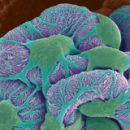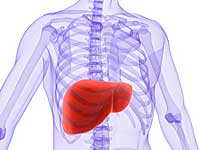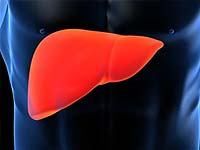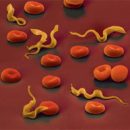Learn how the mechanism of infection with hepatitis C flows, the differences between acute and chronic forms, is there any vaccine when jaundice appears which major symptoms are present.
Content
- Clinical manifestations of acute hepatitis period
- The period of the appearance of jaundice
- Chronic hepatitis C — flow
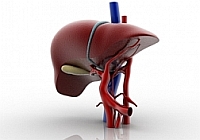 Hepatitis with not in vain called «affectionate killer». He can not manifest any symptoms for a long time, and a person does not even suspect that the carrier of the virus, infecting others. The hepatitis C virus, which has passed a long evolution and mutation, falling into hepatic cells, launches genetic mechanisms of cells that begin to produce their own copies. These copies begin to infect the following healthy liver tissue cells. Hepatitis C virus (HCV) is a RNA virus that participates in the formation and construction of cells. Penetrating inside the hepatic cell, HCV begins reproduction, destroying the cell and causing inflammation.
Hepatitis with not in vain called «affectionate killer». He can not manifest any symptoms for a long time, and a person does not even suspect that the carrier of the virus, infecting others. The hepatitis C virus, which has passed a long evolution and mutation, falling into hepatic cells, launches genetic mechanisms of cells that begin to produce their own copies. These copies begin to infect the following healthy liver tissue cells. Hepatitis C virus (HCV) is a RNA virus that participates in the formation and construction of cells. Penetrating inside the hepatic cell, HCV begins reproduction, destroying the cell and causing inflammation.
HCV is a very strong virus, which is able to quickly change its properties and the structure of the shell. Because of such mobility, the body does not have time to react to change, giving an accurate and targeted response of the immune system for viral activity. 6 genotypes (species) of HCV are open, which have a significant impact on the duration and efficacy of antiviral therapy. This involves the difficulty of searching for a vaccine against HCV.
Clinical manifestations of acute hepatitis period
Asymptomatic hidden period when hepatitis C can last from twenty days to 12 months, and sometimes not manifestation at all until the symptoms of the liver cirrhosis.
The sharp period of hepatitis C lasts from 14 to 20 days, all this time there is a weakness, dyspeptic symptoms (digestion disorders), pain in muscles and joints. This flow carries a rude character. Special attention should be paid to frequent fatigue and persistent depression — These symptoms often remain the only manifestations of chronic hepatitis long before diagnosis.
The number of patients for the first time sick hepatitis C, which detect depressive signs, varies from 35 to 67%. Total intoxication is practically not expressed, if compared with types A and B, only slightly obstacles, weakness, fast fatigue, cough and runny nose are possible. Approximately 15% of the sick hepatitis C flows in acute form, giving the body to cope with the disease itself, eliminating the patient from remote consequences. After an acute period, the patient can recover, the disease can take a chronic character (80% of ill), or a person can become a carrier of the virus.
The period of the appearance of jaundice
 Next comes the stage of jaundice. One of the symptoms, indicating the possible infection with hepatitis C, to which it is worth paying attention to, is a darkening of urine. It acquires a kind of dark beer, becoming a dark brown shade. Take into account her color throughout the day, and not just the morning portion, when because of the night stagnation can darken.
Next comes the stage of jaundice. One of the symptoms, indicating the possible infection with hepatitis C, to which it is worth paying attention to, is a darkening of urine. It acquires a kind of dark beer, becoming a dark brown shade. Take into account her color throughout the day, and not just the morning portion, when because of the night stagnation can darken.
After the jaundice is actively manifested, as a result of which the sclera and mucosa acquire intensive-saturated dark yellow. If you raise the language to the upper sky, you can observe the yellowness of the mouth. Yellow and skin: at first on the palms and feet, and later evenly and the whole body. The appearance of a jaundice softens all the symptoms present before this and the patient feels relief. But the disease resembles a pain in the right hypochondrium and feeling of gravity. If bile moves are cleaned, after the urine changes its color and feces, completely discoloration.
In the case when the course of acute hepatitis with nothing complicates, after about 3.5 months, 76% of patients comes recovery.
Chronic hepatitis C — flow
Chronic hepatitis C can develop both completely independently and after an acute form. The main manifestations of the chronic form of hepatitis C are:
- gradually increasing fatigue, which drowsiness and weakness consistently accompany; It is especially difficult to wake up in the morning;
- Biological rhythm of the body is broken: Night insomnia replaces morning and daytime sleep — characteristic of hepatic encephalopathy;
- Appetite decreases or disappears at all;
- Nausea, vomiting, meteorism (bloating due to accumulation of gases).
Jaundice is possible, but when chronic flow is rarely manifested.
The chronic form of flow is more dangerous by its complications: cirrhosis and liver cancer, which develop in 90% of adults and 20% of children. There are cases (30%) when, when chronic flow, the functionality of the liver is preserved.
Quite rarely observe the rapid, lightning development of hepatitis with. Such a rapid course of the disease occurs if the patient already has cirrhosis or hepatitis B, and also if transplantation was carried out.

